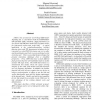Free Online Productivity Tools
i2Speak
i2Symbol
i2OCR
iTex2Img
iWeb2Print
iWeb2Shot
i2Type
iPdf2Split
iPdf2Merge
i2Bopomofo
i2Arabic
i2Style
i2Image
i2PDF
iLatex2Rtf
Sci2ools
102
Voted
ET
2002
2002
Using At-Speed BIST to Test LVDS Serializer/Deserializer Function
LVDS is the acronym for Low-Voltage-DifferentialSignaling and is described in both the ANSI/TIA/EIA644 and IEEE 1596.3 standards. High performance yet Low Power and EMI have made LVDS a popular choice for high-speed card-to-card serial links. A typical application is the serializer/deserializer (ser/des) function where wide TTL datastreams including clock is converted to a serial LVDS bit stream, sent over a cable, and deserialization and clock recovery performed on the receiving card. This is a powerful design technique but presents interesting challenges from a testability perspective. First, LVDS links have a much different fault spectrum than the well-established stuck-at models used for TTL logic levels. The LVDS interconnect is a transmission line model, where the signal carrying integrity of the cable, fault models and fault detection are very frequency dependent. In addition, the Ser/Des function with clock recovery requires the two devices to achieve synchronization, so effor...
Clock Recovery | ET 2002 | LVDS | Serial Lvds |
| Added | 18 Dec 2010 |
| Updated | 18 Dec 2010 |
| Type | Journal |
| Year | 2002 |
| Where | ET |
| Authors | Magnus Eckersand, Fredrik Franzon, Ken Filliter |
Comments (0)

